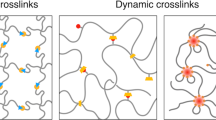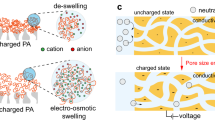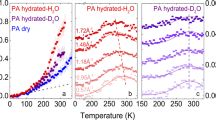Abstract
Hydration and crosslinking in hydrophilic ionic polymers give rise to microstructural features that affect the diffusion of water and proton conductivity. In this work, we show that the local heterogeneities arising from domains that are more cross-linked and regions that are less cross-linked result in differential swelling behavior during diffusion of water and differential stresses during oscillatory deformation. Distinct signatures in the water uptake kinetics and the dynamic mechanical behavior are shown to be due to these heterogeneities, which are prominent at high and intermediate water contents and are unnoticeable or absent at low water contents. Using polyvinyl alcohol (PVA) cross-linked with sulfosuccinic acid (SSA) as a sample system, we show that differential swelling can lead to anomalous diffusion. In addition, the deformation of these polymers, carried out through large amplitude oscillatory shear experiments, results in strain hardening behavior due to the increased viscous dissipation arising from the differential movements of the polymer network due to the local heterogeneities. The proton conductivity of these materials is affected not only by these heterogeneities but also by the water distribution among the two types of hydrophilic groups (–SO3H and –OH) present in the system. Overall, we demonstrate the important role of crosslink heterogeneities and competitive hydration on the transport and deformation behavior of cross-linked hydrophilic ionic polymer systems.
This is a preview of subscription content, access via your institution
Access options
Subscribe to this journal
Receive 12 print issues and online access
$259.00 per year
only $21.58 per issue
Buy this article
- Purchase on Springer Link
- Instant access to full article PDF
Prices may be subject to local taxes which are calculated during checkout














Similar content being viewed by others
References
Wu H, Yu G, Pan L, Liu N, McDowell MT, Bao Z, et al. Stable Li-ion battery anodes by in-situ polymerization of conducting hydrogel to conformally coat silicon nanoparticles. Nat Commun. 2013;4:1943–9.
Li L, Wang Y, Pan L, Shi Y, Cheng W, Shi Y, et al. A nanostructured conductive hydrogels-based biosensor platform for human metabolite detection. Nano Lett. 2015;15:1146–51.
Ismail YA, Mart´ınez JG, Harrasi ASA, Kim SJ, Otero TF. Sensing characteristics of a conducting polymer/hydrogel hybrid microfiber artificial muscle. Sens Actuators B. 2011;160:1180–90.
Hoare TR, Kohane DS. Hydrogels in drug delivery: progress and challenges. Polymer. 2008;49:1993–2007.
Lorenzo FD, Seiffret S. Nanostructural heterogeneity in polymer networks and gels. Polym Chem. 2015;6:5515–28.
Shibayama M. Small-angle neutron scattering on polymer gels: phase behavior, inhomogeneities and deformation mechanisms. Polym J. 2010;43:18–34.
Hassan CM, Peppas NA. Structure and Morphology of Freeze/Thawed PVA Hydrogels. Macromolecules. 2000;33:2472–9.
Berger J, Reist M, Mayer JM, Felt O, Peppas NA, Gurny R. Structure and interactions in covalently and ionically crosslinked chitosan hydrogels for biomedical applications. Eur J Pharm Biopharm. 2004;57:19–34.
De Molina PM, Lad S, Helgeson ME. Heterogeneity and its influence on the properties of difunctional poly(ethylene glycol) hydrogels: structure and mechanics. Macromolecules. 2015;48:5402–11.
Millon LE, Neih MP, Hutter JL, Wan W. SANS characterization of an anisotropic poly(vinyl alcohol) hydrogel with vascular applications. Macromolecules. 2007;40:3655–62.
Ajith C, Deshpande AS. Varughese proton conductivity in crosslinked hydrophilic ionic polymer system: competitive hydration, crosslink heterogeneity, and ineffective domains. J Polym Sci Part B Polym Phys. 2016;54:1087–101.
Lorenzo FD, Hellwig J, Klitzing RV, Seiffret S. Macroscopic and microscopic elasticity of heterogeneous polymer gels. ACS Macro Lett. 2015;4:698–703.
Shibayama M. Spatial inhomogeneity and dynamic fluctuations of polymer gels. Macromol Chem Phys. 1998;199:1–33.
Chasse W, Schlogl S, Riess G, Saalwachter K. Inhomogeneities and local chain stretching in partially swollen networks. Soft Matter. 2013;9:6943–54.
Rhim JW, Park HB, Lee CS, Jun JS, Kim DS, Lee YM. Crosslinked poly(vinyl alcohol) membranes containing sulfonic acid group: proton and methanol transport through membranes. J Memb Sci. 2004;238:143–51.
Ngui MO, Mallapragada SK. Mechanistic investigation of drying regimes during solvent removal from poly(vinyl alcohol) films. J Appl Polym Sci. 1999;722:1913–20.
Ping ZH, Nguyen QT, Chen SM, Zhou JQ, Ding YD. States of water in different hydrophilic polymers—DSC and FTIR studies. Polymer. 2001;42:8461–7.
Smith DW. Ionic hydration enthalpies. J Chem Edu. 1977;54:540–2.
Shafee EE, Naguib HF. Water sorption in cross-linked poly(vinyl alcohol) networks. Polymer. 2003;44:1647–53.
Bondarenko AS, Ragoisha GA. Potentiodynamic electrochemical impedance spectroscopy. Prog Chemom Res. 2005;10:89–102.
Kim DS, Guiver MD, Nam SY, Yun T, Seo MY, Kim SJ, et al. Preparation of ion exchange membranes for fuel cell based on crosslinked poly(vinyl alcohol) with poly(styrene sulfonic acid-comaleic acid). J Memb Sci. 2006;281:156–62.
Hong W, Zhao X, Zhou J, Suo Z. A theory of coupled diffusion and large deformation in polymeric gels. J Mech Phys Solids. 2008;56:1779–93.
Mendes E, Lindner P, Buzier M, Bouc F, Bastide J. Experimental evidence for inhomogeneous swelling and deformation in statistical gels. Phys Rev Lett. 1991;66:1595–8.
Hallinan DT, Angelis MGD, Baschetti MG, Sarati GC, Elabd YA. Non-Fickian Diffusion of Water in Nafion. Macromolecules. 2010;43:4667–78.
Vrentas JS, Jzebski CM, Duda JL. A Deborah number for diffusion in polymer-solvent systems. AICHE J. 1975;21:894–901.
Mason TG, Weitz DA. Linear viscoelasticity of colloidal hard sphere suspensions near the glass transition. Phys Rev Lett. 1995;75:2770–3.
Hyun K, Wilhelm M, Klein CO, Cho KS, Ahn KH, Lee SJ, et al. A review of nonlinear oscillatory shear tests: analysis and application of large amplitude oscillatory shear (LAOS). Prog Polym Sci. 2011;36:1697–753.
Jia D, Hollingsworth JV, Cheng ZZ, Han CC. Coupling of gelation and glass transition in a biphasic colloidal mixture—from gel-to-defective gel-to-glass. Soft Matter. 2015;11:8818–26.
Zhao C, Yuan G, Han CC. Bridging and caging in mixed suspensions of microsphere and adsorptive microgel. Soft Matter. 2014;10:8905–12.
Laurati M, Egelhaaf SU. Nonlinear rheology of colloidal gels with intermediate volume fraction. J Rheol. 2011;55:673–706.
Acknowledgements
The authors acknowledge Fuel Cell Laboratory, Department of Metallurgical and Material Engineering, IIT Madras for providing the facility of impedance spectroscopy.
Author information
Authors and Affiliations
Corresponding author
Ethics declarations
Conflict of interest
The authors declare no competing interests.
Additional information
Publisher’s note Springer Nature remains neutral with regard to jurisdictional claims in published maps and institutional affiliations.
Rights and permissions
About this article
Cite this article
Ajith, C., Deshpande, A.P. & Varughese, S. Effect of crosslink-induced heterogeneities on the transport and deformation behavior of hydrophilic ionic polymer membranes. Polym J 54, 179–190 (2022). https://doi.org/10.1038/s41428-021-00546-3
Received:
Revised:
Accepted:
Published:
Issue Date:
DOI: https://doi.org/10.1038/s41428-021-00546-3



